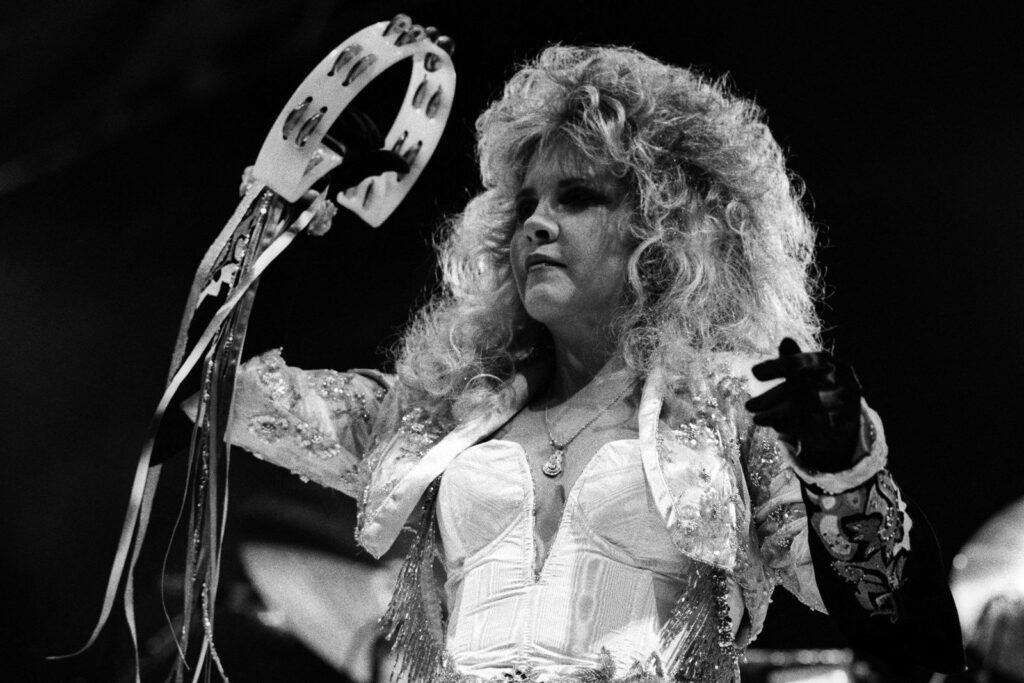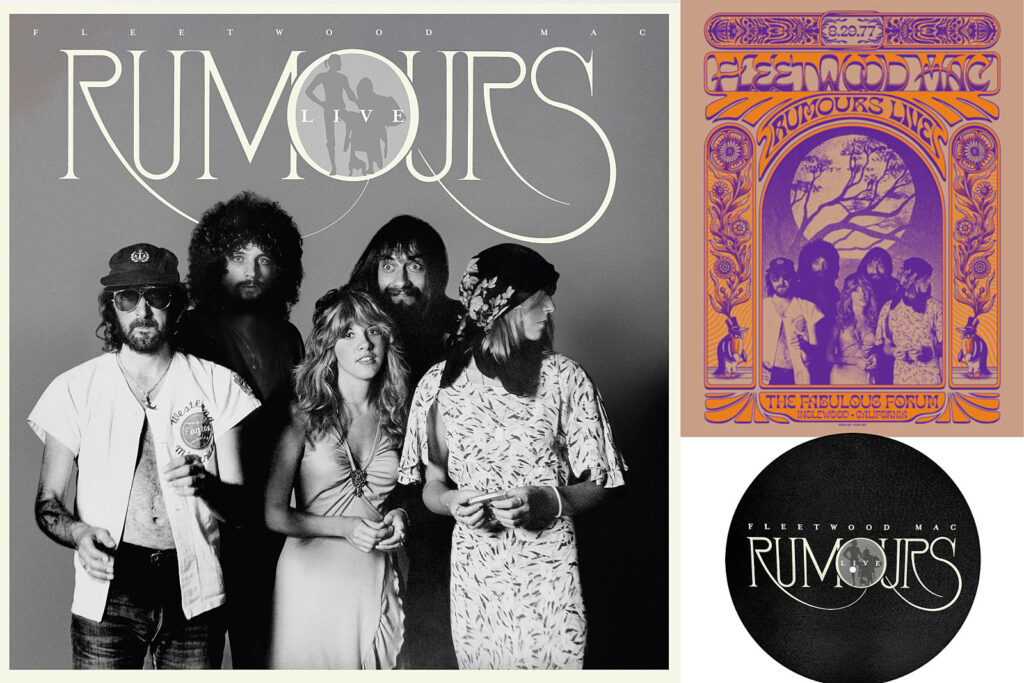How a Soundtrack Reunited Fleetwood Mac for ‘Tango in the Night’

If time has taught us anything where Fleetwood Mac is concerned, it’s that no matter how long they’ve been apart and no matter how many hurt feelings lie between them, there’s always unfinished business between the members of the group.
The only question is when that business will be attended to, and what it’ll take to make it happen. The answer to that question has taken some odd forms in the past — perhaps none odder than the series of events that led to the band reuniting for 1987’s Tango in the Night LP.
With 1982’s Mirage, Fleetwood Mac enjoyed a commercial rebound that helped soothe some of the sting from the reception afforded its predecessor, 1979’s divisive Tusk. From a creative standpoint, however, it wasn’t the band members’ most satisfying experience, and while they each seemed to feel they owed themselves another record, there wasn’t any sense of urgency.
Instead, most Mac members scattered to focus on various solo efforts: Between 1983 and 1985, Mick Fleetwood, Lindsey Buckingham, and Christine McVie all released solo albums, while Stevie Nicks released two.
It was actually a solo project of sorts that ended up providing the necessary spark. While assembling the soundtrack for the Blake Edwards movie A Fine Mess, producers reached out to Christine McVie, asking her to record a new version of Elvis Presley‘s “Can’t Help Falling in Love.”
It was just one of several covers on the record, which also included appearances by the Temptations, Billy Vera, Smokey Robinson, and Los Lobos — an impressive array of talent that ended up getting better reviews than the movie itself.
Read More: Fleetwood Mac Albums Ranked Worst to Best
A Fine Mess, released in August of 1986, started out as a remake of the Laurel & Hardy comedy The Music Box, but by the time it arrived in theaters, it was woefully obvious that the picture had strayed quite far from its roots.
Edwards, once known for dependably delivering uproarious laughs, was deep in a career slump he never quite recovered from, and in lieu of sharp gags, he resorted to a series of loud set pieces that couldn’t disguise the script’s many deficiencies. Stars Ted Danson and Howie Mandel, who were both trying to break into film after finding success on TV, weren’t enough to keep the end result from being one of the year’s biggest critical and commercial bombs.
Watch the ‘A Fine Mess’ Trailer
The silver lining to all this? McVie’s cover of “Can’t Help Falling in Love,” which indirectly led to the next Fleetwood Mac album.
“It was really Christine McVie who reunited Fleetwood Mac,” recalled Mick Fleetwood in his 1991 memoir Fleetwood: My Life and Adventures in Fleetwood Mac. “It started when she called John Courage out of his Hawaiian exile to help her make an album in Switzerland, and eventually to manage her career.
Christine had been asked to record Elvis’s ‘Can’t Help Falling in Love’ for the soundtrack of the film A Fine Mess. She called in Richard Dashut to produce, who in turn said that Lindsey was a real Elvis fan and might like to get involved. Then John Courage called me and John McVie, and in August 1985 four-fifths of Fleetwood Mac found themselves in the studio, cutting this record. This was fun, and the seed that eventually grew into Tango in the Night.”
“I just thought it was a good idea,” McVie told the Associated Press in 1987. “It was a natural progression. We all got into the studio and started playing some of the old songs. We hadn’t been gathering dust as much as we thought. We decided to get serious about making another album.”
Hear Christine McVie Perform ‘Can’t Help Falling in Love’
Of course, as Fleetwood Mac fans have long understood, things with the band always had a tendency to get complicated, and this was also the case for the early Tango sessions. At this point, each of the creative principals had their own solo success to fall back on, and concessions had to be made in order for everyone to feel like they were retaining enough creative autonomy to make a reunion worthwhile. By Fleetwood’s own admission, he was really the only one who was jonesing to get the group back together, and a lot of that had to do with his 1984 bankruptcy filing.
Still, even if the other members of the band weren’t in a big hurry to reconvene, most of them were generally open to it. Stevie Nicks quickly committed despite tour and promotional obligations for her 1985 Rock a Little LP, and she was soon joined by Christine and John McVie.
Lindsey Buckingham proved the longest holdout; not only was he enjoying the less constrained creative process of a solo career, he was also partway through his next album, which he’d been working on with Dashut. “Eventually,” said Fleetwood, “we worked to build enough momentum that we were able to convince Lindsey it might go off without him. When Lindsey said he was in, things went forward.”
Getting everyone to agree on a new album was a major hurdle, but others remained — first among them the question of who’d actually produce the thing. Feeling that they needed an outside producer to ride herd over this group of strong-willed personalities, and interested in bringing their sound in line with then-current trends, they initially met with Nile Rodgers.
When that failed to spark, they hooked up with Jason Casaro, who was hot at the time due to his work on the first Power Station LP; this led to what Fleetwood referred to as “a week of glorified rehearsals” that were conducted without Nicks, who was on tour in Australia. When those sessions also failed to produce workable material, the project fell into a period of suspended animation, and for a time, it seemed somewhat doubtful that an album was actually in the offing. Ultimately, they turned once more to Buckingham and Dashut, who’d been behind the boards for Tusk and Mirage.
Even with all the pieces finally assembled, Tango‘s journey to record stores still wasn’t easy; all told, it took roughly a year and a half to get it finished, and more messiness between the members of the group was waiting on the other side of its Top Ten chart success and 15 million copies sold. Future hiatuses, lineup shuffles, and solo ventures were yet to come — each of them leaving fans waiting for the next Fine Mess-style twist of fate that might lead to the next reunion.
Fleetwood Mac Lineup Changes: A Complete Guide
A look at the many changes the band has been through over its half-century career.
Gallery Credit: Dave Swanson
Link to the source article – https://ultimateclassicrock.com/fleetwood-mac-tango-in-the-night-a-fine-mess/
-
M-Audio AIR 192×4 USB C Audio Interface for Recording, Podcasting, Streaming with Studio Quality Sound, 1 XLR in and Music Production Software$119,00 Buy From Amazon
-
BOSS MIDI Cable (BMIDI-2-35)$19,99 Buy From Amazon
-
Donner Electric Guitar LP Solid Body, Full-Size 39 Inch Electric Guitar Beginner Kit Black with Bag, Cable, Strap, DLP-124B$149,99 Buy From Amazon
-
Ibanez 5 String Bass Guitar, Right, Walnut (GSR205BWNF)$279,99 Buy From Amazon
-
Montreux Bb Cornet, Gold (SCR701)$0,00 Buy From Amazon
-
Otamatone “Neo” 10th Anniversary Special Edition [Japanese Version] Black – Japanese Electronic Musical Instrument Synthesizer$49,99 Buy From Amazon












Responses